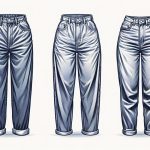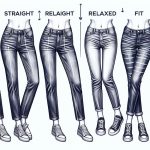Are you tired of feeling frustrated and overwhelmed when trying to find the perfect fit for your clothes? Do you often find yourself wondering how gap sizes run and how to measure yourself at home?
Look no further because this comprehensive guide is here to help you find your perfect fit! Understanding gap sizes and what factors affect them is crucial in finding clothes that fit you well. Measuring yourself accurately at home can also make the process easier and more efficient.
Whether you’re looking for the perfect pair of jeans, dress, or shirt, this guide will provide you with tips and tricks to help you find your ideal fit. Say goodbye to the frustration of ill-fitting clothes and hello to a wardrobe that makes you feel confident and comfortable.
Table of Contents
Understanding the Basics of Gap Sizes
So you’re trying to find the perfect fit, huh? Well, let’s start by understanding the basics of gap sizes – it’s all about finding that sweet spot between too tight and too loose.
Gap sizes refer to the measurement between the waistband of your pants or shorts and your actual waist. It’s important to note that gap sizes can differ between brands, so don’t assume that a certain size will always fit you perfectly.
When it comes to gap sizes, you want to avoid going too tight or too loose. If your pants are too tight, they’ll be uncomfortable and unflattering. On the other hand, if your pants are too loose, they’ll look baggy and sloppy.
The key is to find a size that fits comfortably around your waist without feeling too tight or too loose. To determine your gap size, you’ll need to measure your waist. Use a tape measure to measure the circumference of your waist at the narrowest part, typically near your belly button.
Once you have your measurement, check the sizing chart for the brand you’re interested in. Keep in mind that sizes can vary between brands, so it’s always a good idea to try on a few different sizes to find your perfect fit.
Factors That Affect Gap Sizes
Factors like body shape, clothing materials, and type of activity can all impact the space between your thighs when standing or sitting. For example, those with wider hips may naturally have a larger gap, while those with narrower hips may have a smaller gap.
Additionally, tight clothing materials like denim or spandex can compress the thighs, causing a smaller gap, whereas looser materials like linen or cotton can create a larger gap. The type of activity you engage in can also affect your gap size.
If you frequently engage in exercises that target the inner thighs, such as squats or lunges, you may notice a larger gap due to increased muscle development. On the other hand, if you primarily engage in activities that do not require much inner thigh engagement, your gap size may remain relatively unchanged.
It’s important to keep in mind that gap size is not an indicator of health or fitness. Everyone’s body is different and unique, and gap size should not be used as a measure of worth or attractiveness. Instead, focus on finding clothing that fits comfortably and flatters your body shape, regardless of the size of your gap.
Measuring Yourself at Home
To ensure accurate measurements when measuring yourself at home, you’ll need a few tools and some helpful tips. First, make sure you have a flexible measuring tape and a mirror to assist you.
Next, focus on the key measurement points, such as the bust, waist, and hips, to ensure you get the most accurate fit.
With these tools and tips in hand, you’ll be on your way to finding your perfect gap size.
Tips for Accurate Measurements
You’ll want to grab a measuring tape to ensure accurate measurements for finding your perfect gap size fit. But before you begin, here are some tips to make sure your measurements are as accurate as possible:
-
Stand up straight: Make sure you’re standing up straight when taking your measurements. Slouching or leaning can affect the accuracy of your measurements.
-
Use the right tape: A flexible measuring tape is the best way to ensure accurate measurements. Avoid using a ruler or a stiff tape measure as these can give you inaccurate results.
-
Don’t pull too tight: When measuring, make sure the tape is snug against your body, but not too tight. Pulling too tight can cause the measurements to be smaller than they actually are.
By following these tips, you can be confident that you’re getting accurate measurements, which will help you find your perfect gap size fit.
Tools Needed for Measuring
To measure accurately, all you’ll need is a flexible measuring tape and good posture. Make sure you have a measuring tape that’s at least 60 inches long to accommodate for all body types. A flexible tape is important because it can contour to your body and give you the most accurate measurement.
When using the measuring tape, stand up straight with your shoulders relaxed and arms down by your sides. It’s important not to suck in your stomach or puff out your chest as this will distort the measurements.
For the most accurate results, have someone else take the measurements for you or use a mirror to ensure the tape is straight and parallel to the ground. With these simple tools and posture adjustments, you’ll be well on your way to finding your perfect fit.
Common Measurement Points
Achieving accurate measurements requires utilizing common points on the body, which can vary based on the garment being measured for.
For example, when measuring for pants or skirts, the waist and hip areas are critical points to take into account. To measure the waist, wrap a tape measure around the narrowest part of your torso, typically located above your belly button. For the hip area, measure around the fullest part of your hips, usually around 8 inches below your waist.
When measuring for tops, it’s crucial to measure the bust and shoulder areas. To measure the bust, wrap a tape measure around the fullest part of your chest, making sure the tape is level across your back. For the shoulder area, measure from the base of your neck to the edge of your shoulder, where your arm meets your shoulder.
Taking measurements at these common points will ensure that you can find the perfect fit for your clothing, no matter what garment you are measuring for.
Finding Your Perfect Fit in Jeans
When it comes to finding the perfect fit in jeans, there are three key points to keep in mind:
- Choosing the right rise
- Selecting the best length
- Finding the right waist size
You want to make sure the rise of your jeans fits comfortably at your waistline, while also considering the length that works best for your height and preferred style. Lastly, finding the right waist size is crucial to achieving a flattering fit that hugs your curves in all the right places.
Choosing the Right Rise
Picking the perfect rise for your jeans can make all the difference in how comfortable and flattering they feel. The rise refers to the distance between the crotch and the waistband, and there are three main types: low rise, mid rise, and high rise.
Low rise jeans sit below the belly button and are great for those with a shorter torso or who prefer a more casual look. Mid rise jeans sit at the natural waistline and are a versatile option that can work for many body types. High rise jeans sit above the belly button and can elongate the legs and create a more polished look.
When choosing the right rise, it’s important to consider your body shape and personal style. If you have a longer torso, high rise jeans may be the most flattering option for you. If you have a shorter torso, low rise jeans may be a better choice.
It’s also important to think about where you’ll be wearing your jeans and what kind of look you’re going for. A low rise jean may be perfect for a casual day out, but a high rise jean may be more appropriate for a dressier occasion.
Overall, finding the right rise is all about balancing comfort and style to create a look that makes you feel confident and comfortable.
Selecting the Best Length
Now that you’ve found the right rise for your body type, it’s time to move on to selecting the best length for your jeans. Finding the perfect length is crucial as it can make or break the overall look of your outfit. The length of your jeans affects how they fall on your shoes, how they flatter your legs, and how comfortable you feel in them.
So let’s dive in and explore how to select the best length for your jeans. The length of your jeans will depend on your height, leg shape, and personal style. For instance, if you’re on the shorter side, you may want to opt for a cropped or ankle-length jean to elongate your legs. On the other hand, if you’re tall, you may want to go for a longer inseam to avoid the dreaded high-water look.
Additionally, the style of your jeans can also affect the length. Skinny jeans, for example, tend to be longer than boyfriend jeans or wide-leg jeans. So when shopping for jeans, make sure to pay attention to the inseam length and try on different styles to see what works best for you.
Finding the Right Waist Size
It’s essential to pay attention to your waist size when selecting jeans that fit comfortably and flatter your body shape. Finding the right waist size may seem challenging, but it doesn’t have to be.
Here are a few tips to help you find your perfect fit:
-
Measure your waist using a tape measure and make sure to measure at the narrowest point, which is typically just above your belly button.
-
Take into account the type of fit you prefer. If you like a more relaxed fit, consider choosing a waist size that is slightly larger than your actual waist measurement. If you prefer a more fitted look, go for a waist size that is closer to your actual measurement.
-
Keep in mind that different brands may have different sizing, so don’t be afraid to try on different sizes to find the one that fits you best.
By paying attention to your waist size and considering your preferred fit, you’ll be able to find the perfect pair of jeans that flatter your body shape and keep you comfortable all day long.
Finding Your Perfect Fit in Dresses
You deserve to feel confident in a dress that fits you perfectly, so let’s explore how to find your ideal fit.
When it comes to dresses, you need to consider not only your waist size, but also your bust and hip measurements. Take a measuring tape and wrap it around the fullest part of your bust, the narrowest part of your waist, and the widest part of your hips. These measurements will help you determine your size in different brands and styles.
Next, pay attention to the cut and style of the dress. A-line dresses are a great option for those with wider hips, while wrap dresses can flatter any body shape. If you have a smaller bust, opt for dresses with ruffles or embellishments to add some volume. On the other hand, if you have a larger bust, look for dresses with a V-neckline or a fitted bodice to provide support and balance out your silhouette.
Lastly, don’t be afraid to try on different sizes and styles until you find your perfect fit. Sizes can vary between brands and even between different styles within the same brand. Trust your instincts and choose a dress that makes you feel confident and beautiful.
Remember, the most important thing is to feel comfortable and confident in your own skin, and a well-fitting dress can help you achieve just that.
Finding Your Perfect Fit in Shirts
Discovering the ideal fit for shirts involves taking into consideration various factors, such as the fabric, cut, and style. When it comes to the fabric, make sure it’s comfortable and breathable, especially if you plan to wear the shirt for an extended period.
For the cut, look for a style that flatters your body shape and emphasizes your best features. Finally, choose a style that complements your overall aesthetic and personality.
To find the perfect fit, start by measuring your chest, waist, and hips. Use these measurements to compare with the sizing chart provided by the brand or retailer. It’s essential to note that sizing can vary between brands, so always check the sizing chart before making a purchase.
If you’re between sizes, it’s better to size up, as you can always get the garment tailored to fit your body perfectly.
When trying on a shirt, pay attention to how it fits around the shoulders, chest, and waist. The shoulders should sit comfortably and not droop or bunch up. The chest should fit snugly without pulling, and the waist should not be too tight or too loose. Lastly, check the length of the shirt, as it should be long enough to tuck in or leave untucked comfortably.
With these tips in mind, finding the perfect fit for shirts will be a breeze.
Tips and Tricks for Finding Your Perfect Fit
Get ready to nail your shirt game with these essential tips and tricks for finding the perfect fit.
First, always try on shirts before purchasing them, and make sure to move around in them to test their comfort and fit. Don’t be afraid to ask for a second opinion from a sales associate or a friend, as they can offer a fresh perspective on how the shirt looks on you.
Second, pay attention to the fabric and how it will fit your body. If you’re looking for a slim fit, opt for fabrics with stretch, such as cotton blends or spandex. If you prefer a looser fit, look for fabrics that have a relaxed drape, such as linen or rayon. Keep in mind that some fabrics may shrink after washing, so it’s important to take that into consideration when choosing the right size.
Don’t forget to consider the cut of the shirt. Different cuts, such as slim, regular, or relaxed, will fit differently on your body. Make sure to choose a cut that complements your body type and accentuates your best features.
With these tips and tricks in mind, you’ll be able to find the perfect shirt that not only fits well but also makes you feel confident and stylish.
- Does Chiffon Fabric Stink - July 15, 2025
- Does Chiffon Fabric Affect the Economy - July 15, 2025
- Does Cotton Fabric Have a Nap - July 15, 2025





